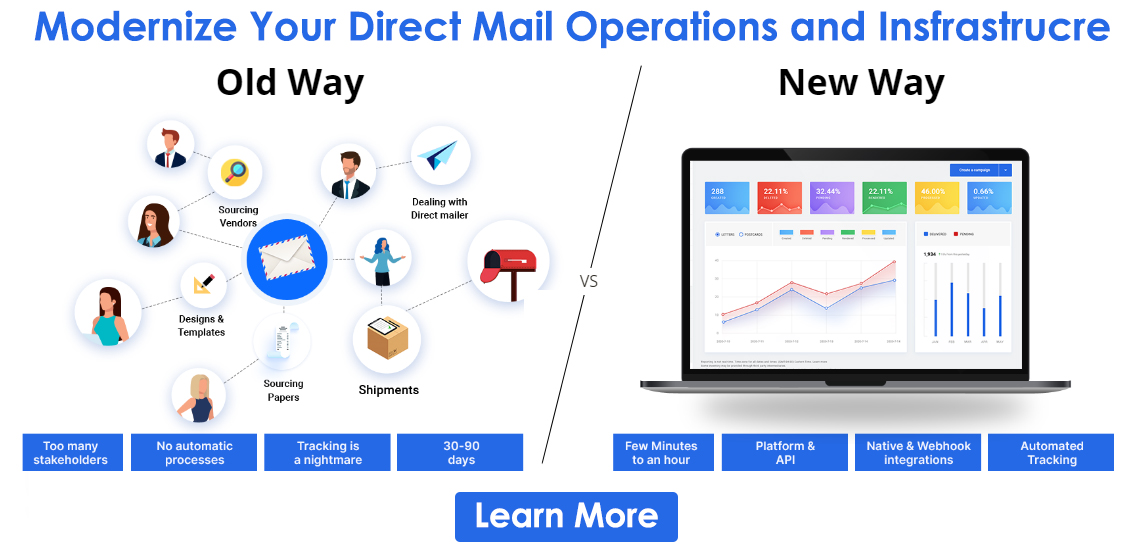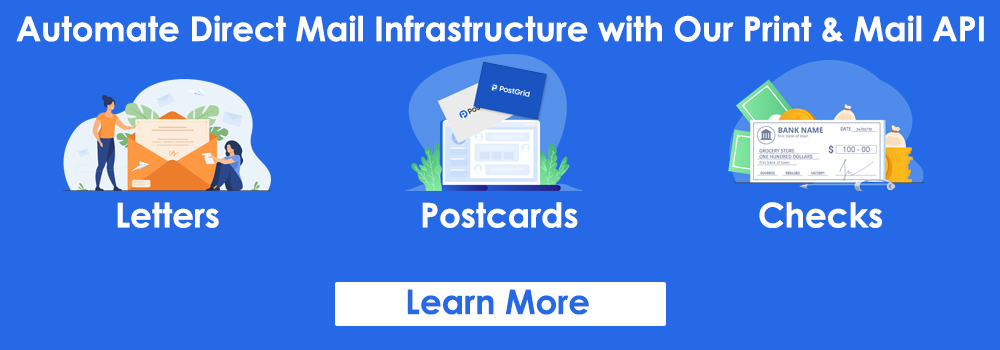Direct Mail Response Rate
What is a Good or Average Direct Mail Response Rate for Direct Mail Marketing?
Have you ever wondered how you can get a better result for your direct mail campaigns? Direct mail campaigns are just like any other marketing campaign; you need to use insights or data to your advantage if you hope to bring feasible improvements to your direct mail campaigns. The only way to ensure the success of your marketing campaigns is by closely monitoring its response rate and constantly making changes to your campaigns.

So, the direct mail response rate and how you use it is a crucial aspect that could very well decide the fate of your campaigns. This brings us to the question, “How can we effectively use direct mail response rate to boost conversions and generate leads?” But, the answer to this question is not that simple, and you need to have a good understanding of the direct mail response rate and also how to use it to realize the true potential of your direct mail campaigns.
Direct mail response rate can vary significantly based on how well you have planned your direct mail campaigns. Even the minutest element in your direct mail can significantly impact your overall campaign performance, including direct mail acquisition response rates. When dealing with the response rate of your marketing campaigns, it is important that you stay realistic because not every direct mail you send will not lead to conversions.
Similarly, there are many variable factors that you need to factor in before deciding the effectiveness of your direct mail campaigns. The direct mail response rate is a vital metric that can help you in doing just that. This article discusses the direct mail response rate and its significance in creating a direct mail strategy that actually works for your business. We also take you through some of the ways which explain how to increase direct mail response rates and more.
How Can You Measure The Direct Mail Response Rate
The response rate is basically a reflection of the percentage of people or target audience that has responded to your direct mail campaign. It is one of the most easily measurable metrics that can convey the effectiveness of your direct mail campaigns. Businesses often rely on direct mail response rates than any other measurable metrics because it is both a simple and effective way to analyze your campaigns. Below we discuss how your business can determine its direct mail response rate.
As we have already mentioned above, the determination of the direct mail response rate for your business’s campaigns is pretty simple. All you have to do is just take a count of the number of responses that you have received from a specific direct mail campaign and then divide the same with the total number of mail sent out for that campaign. Similarly, you can also consider using the same method for determining your business’s overall direct mail response rate.
To understand this better, consider that a business sends out 2500 mailpieces as part of their direct mail campaign. Suppose that out of these 2500 mailpieces sent out by the business, they receive responses from 50 of them. Once you do the math, the response rate would be obtained as 2% in this case. Businesses must consider streamlining their direct mail operations using advanced automated solutions like PostGrid to ensure the best result for their campaigns.
What Is The Average Direct Mail Response Rate?
Typically, all marketing campaigns tend to have a low response rate regardless of what medium they use for the communication, but that is not always the case. The average direct mail response rate can be anywhere from 2 to 4%. Although this may seem disheartening at first glance, there is more to it than you might think. Below we discuss some of the instances where the response rate can vary and mean different results depending on the situation and environment it is employed in.
Target Audience Outside Mailing List
Even a 2% direct mail acquisition response rate is still considered to be good if your target audience were people outside your company’s mailing list. Remember that in the case mentioned above, your target audience is practically a stranger to your brand. They may or may not have heard of your brand before.
Even if they are familiar with your brand, it is unlikely that they’ve had the first-hand experience with the product or service offered by your company. Considering all this and the response rate of other marketing methods, even an average 2% response rate is exceptional.
Enticing The Audience With a Free Offer
The best way to generate a response from the target audience is to offer them something that they consider to be valuable. You will see an even better result for your direct mail campaigns if what you are offering to the target audience involves them making little to no commitments.
All you have to do to accomplish this is to create a white paper that is highly relevant to your target audience and the product/service you sell. The report or white paper is then offered to your target audience. Once you’ve sent the mail, you just sit back and wait for their response.
Since the offer is free, such direct mail campaigns are bound to get a higher response rate than the others.
Even though 2% is the average response rate expected from direct mail, that is not necessarily the case every time. Remember how earlier in the article we said about keeping realistic standards when it comes to direct mail response rate. Because more often than not, businesses see a 1% or lower response rate and whether or not this rate goes up depends on your direct mail optimization. A well-optimized direct mail campaign that employs advanced tools like PostGrid can get you response rates as high as 5%.
When Can You Expect Higher/Lower Than Average Direct Mail Response Rate
As discussed above, expecting a 2% or even 1% direct mail response rate is adequate or even great when you are mailing to new audiences. But, there are situations when a 2% response rate is unacceptable for direct mail because it failed to reach its potential. Below we discuss a couple of situations in which a 1 or 2% direct mail response rate is:
- Considered inadequate
- Considered extremely high
Previous Responders as Target Audience
Earlier, we stated that a 2% response rate could be considered fairly good if the target audience is outside your mailing list or has had no direct interaction with your brand before. However, it is a whole different story if the target audience is a list of previous responders who have not only interacted with your brand but have also responded to your direct mails. When it comes to targeting previous responders using your business’s direct mail campaign, you should expect a response rate that is several times higher than 2%.
The logic behind this is pretty self-explanatory. It is extremely hard to convince a stranger who may have no previous interaction with your brand, establish trust, and entice them into conversion. But, when it comes to a target audience who has already interacted with your brand and to whom you have already demonstrated your expertise, you are supposed to generate a better response. Furthermore, from precious responses, we know such an audience is also likely interested in the product or service you are going to pitch them with.
A saying is often spoken among the direct mail marketing circle, which goes, “the profit is in the list,” and it couldn’t be any more true. Half the trouble or perhaps, even more, when it comes to conducting direct mail marketing campaigns for businesses is to find a rock-solid target base. When you use previous responders as your target audience, you get as good a target base as any. Catalogue and other mail order businesses make a huge chunk of their money by targeting their in-house list for direct mail marketing.
Substituting Free Offers With Price Offers
Earlier, we discussed using free offers that require little to no commitment from the target audience who has zero previous interactions with your brand to boost engagement. Using such offers may generate a 2% direct mail response rate even from a target audience that is mostly unaware of your brand. On the other hand, if you substitute the free offers with price offers, you are bound to get a lower res[onse rate.
You may have already guessed this much. However, what you may not have figured out is that using price offers instead of free offers could significantly bring down the response rate far beyond what you may even dare to speculate. More often than not, the difference in response range rages in the fractions of 2 or even 1% response rate that you get from free offers.
Here lies the difference between lead generation and older generation. When it comes to the older generation, you expect the target audience to place an actual order. This could be done through any form of payment or even an agreement to pay. It is not hard to understand even if you are offering a significant discount or an EMI option; the price is still very a barrier when it comes to response rates.
Why You Should Never Turn a Blind Eye to Response Quality
We know that the direct mail response rate tells us how many people have responded to a direct mail campaign initiated by a business or company. But, it is also known that the direct mail response rate does not really tell you anything about the quality of the response that you get from the direct mail campaigns.
To understand the concept of response quality on an application level, consider this, you can effectively use free offers to generate leads, but it’s not necessary that all of the leads generated will convert to buyers. Marketers sometimes overlook the quality part of the direct mail response rate as they get too held up by the quantity part.
But, both quality and quantity are part of the same equation, and you need to nail both of them if you want to improve your direct mail marketing result. The quality of your direct mail responses must go hand in hand with its quantity. Below we take a look at an example of two direct mail campaigns that will help you better understand the significance of response quality.
Suppose a company runs two direct mail campaigns, each with its own team and manager. While team A produces a 2% response rate, team B has only a 1% response rate for their campaign. On the other hand, team A can convert 5% of their leads to buyers or customers, while team B can convert 30% of their target audience that has responded to a valuable customer.
If we were to assume that both team A and team B had mailed 1000 mailpieces each, then a 2% response rate of team A would convert to about 20 leads. Similarly, the 1% response rate produced by team B would imply that it generates ten leads. Although it may seem that team A is doing a better job than team B at this point but getting the full picture, you also need to consider the conversion rates of both.
As we examine the conversion rates of team A and team B, which are 5% and 30%, respectively, we start to notice aspects that we would have missed earlier. While the 5% conversion rate obtained by team A only translates to 1 customer that actually buys their product/service. At the same time, the 30% conversion rate of team B would imply that the company will gain at least three customers.
This ultimately means that despite having a higher response rate, team A still lagged behind when it came to quality. Whereas team B, despite having a much lower direct mail response rate for their campaign, effectively converted more of their target audience to valuable customers. Here lies the importance of quality over quantity and why businesses should never ignore it.
Direct Mail Response Rate & Mailing Costs
Regardless of whether you are a marketer or an entrepreneur or someone that holds a managerial role keeping the cost down for your business is always a priority. The only way you can get an optimized ROI or Return on Investment for your business is if they keep their cost down to a minimum, and it is no different for mailing costs. There are various aspects that can affect your mailing cost, and some of the major ones include the use of bulk mails, the postal service provider you choose and more.
If your business were to use a fully personalized postal mail to target your potential customers that uses printed in vibrant colours, and shipped using first class mail, then your mailing costs are bound to go up. However, the quality argument is true in this case as well because, by the end of the day, you want results from your direct mail campaigns. This means using such personalized and top-quality mailing products and services for better results.
That being said, business direct mail can work best using a postcard rather than a sealed envelope mail because of its overall concise nature as well as its ability to include attractive pictures/infographics. But, most importantly, while first-class mail can cost you $1.50 per piece, using a postcard for your direct mail campaign can bring down your mailing costs to 50 cents per piece. As you can see, the difference in the price is a significant one here and identifying this price difference can save you a lot of money.
To put things into perspective, imagine that company A uses direct mail with sealed envelopes that cost $1.50 per piece and company B uses postcards that cost just 50 cents per piece. Now, if both companies were to send 1000 mailpieces each to their respective target audience, company A would end up paying $1500 while company B will be able to do it in just $500. So, as you can see, even the small difference between $1.5 and 50 cents can add up to a significant amount when it comes to business operations.
The best approach a business can take to ensure that they don’t end up paying a good part of their capital on sending the direct mail and get the most profit out of it is to consider the Cost per Response of your campaign. By calculating the cost per response of your direct mail campaigns, you will be able to differentiate your successful campaigns from the slow performing ones and draw conclusions on what you did right or wrong in each of those campaigns.
How is Direct Mail Different or Similar From Advertising
We have already compared one direct mail campaign with another, and doing this is pretty simple and straightforward because, ultimately, the principle behind them remains the same. However, a comparison that is not often discussed is the one between direct mail and advertising. Although some people may classify direct mail as a form of advertisement, that wouldn’t be accurate per se because both of them have unique features that clearly separate them from each other.
Both direct mail and advertisements are aimed at marketing a specific product or service that a company has to offer. It is not hard to come across companies that effectively employ both these marketing strategies for their business. So, it is only natural that the stakeholders will want to know how well their direct mail and advertisements are doing against each other. Such a comparison would reveal which marketing strategy works best for their business and cut back on expenses by negating them.
The only question now is how we can compare direct mail campaigns to advertisements in an effective way? The answer, however, is a simple one. All you have to do is compare the Cost Per Response of your direct mail campaign and advertisements. The Cost Per Response is a common denominator that can effectively tell you how well or bad your direct mail campaigns and advertisements are doing. In fact, you can use Cost Per Response as a denominator on pretty much all marketing strategies.
Conclusion
Direct mail is one of the most effective marketing strategies out there. It is quintessential for businesses that regularly use direct mail for their marketing and communication purposes to optimize their operations. The direct mail response rate is a clear indicator of how well or bad your direct mail campaigns are doing. You need to carefully analyze the response rate quality if you want to attain a direct mail marketing success rate for your business.
To ensure the best performance of your direct mail campaigns, you must consider employing an advanced direct mail automation tool like PostGrid. PostGrid enables you to personalize and mail your postcards, brochure, product catalogue, and more with ease with an advanced API. The automation capability combined with the address verification feature enables you to get the best out of your direct mail campaigns.
The post Direct Mail Response Rate appeared first on PostGrid.
source https://www.postgrid.ca/direct-mail-response-rate/
source https://postgridcanadainc.tumblr.com/post/658980928952107008
source https://harveywilson355.tumblr.com/post/658984180878819328



Comments
Post a Comment